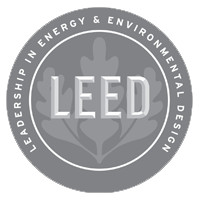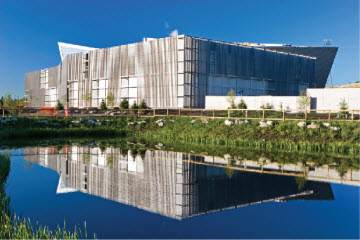Baseline’s Guide to LEED®
What is LEED®?
The U.S. Green Building Council’s LEED® green building program is the preeminent program for the design, construction, maintenance and operations of high-performance green buildings. Learn more at usgbc.org/LEED.

To achieve a level of LEED certification, a project earns points based on how well it meets the criteria in the applicable categories. The USGBC launched the LEED green building rating system in 2000. Since that time, the rating system has gone through a number of revisions. LEED v4, released in late 2013, is the current version of LEED. Teams may still register projects under LEED v3/2009 until October 31, 2016.
With LEED’s focus on sustainability and environmental performance, water efficiency and water conservation has always been important in LEED rating systems. Projects can earn points for implementing water saving strategies such as designing with drought-tolerant plant materials, installing weather-based or soil moisture sensor-based irrigation controllers, and using non-potable water for irrigation.
Baseline products can help you achieve LEED points
Baseline’s irrigation controllers, soil moisture sensors, and other products can help you meet water reduction goals and qualify for points in the LEED water efficiency credits.
As with any system, several variables can affect the total water savings. For one, irrigation control systems can only save water that is currently being wasted. The EPA, through its WaterSense® program, has stated that as much as 50% of the water used on landscapes is wasted. Though the EPA is careful to mention that this number comes from “many industry experts” and is not an official EPA number, it is the most widely used number.
Based on the 50% number and proper installation and programming, Baseline customers should experience a reduction in total water use from our biSensor™ soil moisture sensors of between 25-35%. Generally this fluctuation depends on the amount of summer rains, the more summer rain the more savings potential. LEED considers water usage in the month of July as its reference point.
Baseline’s irrigation controllers also have the unique ability to set a higher priority for zones that have completed a soak cycle. This feature ensures the best possible balance between infiltration and evaporation while automatically managing the water window. This can greatly reduce the effects of evaporation and allow the water to move deeper into the soil, further enhancing root development.

TELUS Spark is LEED® certified to Gold level
TELUS Spark is LEED® certified to Gold level TELUS Spark is a science center located on a 15-acre site in Calgary, Alberta, Canada.
The irrigation system is supplied from a 2-acre onsite storm water management pond. A BaseStation 3200 irrigation controller manages the 3″ BHM hydrometer on the discharge main of a 75 USgpm @ 80psi VFD vertical-turbine pump feeding a 24-zone system of comprising 7 hydrozones each equipped with a biSensor soil moisture sensor.
Proper use of the Intelligent Soak Cycle™ feature will save approximately 10-30%. This variability is from a combination of factors such as soil density, slope, and application rate. This feature typically conserves more water in July than other months because there are usually more irrigation cycles during this month.
When non-potable water is available for irrigation, a Baseline controller can be used to automate many of the potentially complex functions required to operate this type of water supply. With Baseline’s BaseStation 3200 irrigation controller, you can assign 8 POCs and then configure priorities that tell the controller which water source to use first. Refer to the Advanced Programming documents in Baseline’s Knowledgebase for additional information.
Controller Efficiency
If your LEED project is registered under LEED v3/2009, you may be looking for a Controller Efficiency (CE) or Control Factor (CF) number to plug into the irrigation design case calculation.
Because of the variability from project to project, we hesitate to assign a specific number that can be used on every project. However, based on water savings data collected from Baseline customers, we estimate that our BaseStation 1000 or BaseStation 3200 irrigation controllers equipped with Baseline’s biSensor™ soil moisture sensors support an average water savings of 30%. Please review the section on Controller Efficiency in our LEED v3/2009 guide linked below.
Baseline’s LEED Resources
- Baseline’s Guide to the Water Efficiency Credits in LEED v3/2009
- Baseline’s Guide to the Outdoor Water Use Reduction Credits in LEED v4
LEED®, and its related logo, is a trademark owned by the U.S. Green Building Council® and is used with permission.

